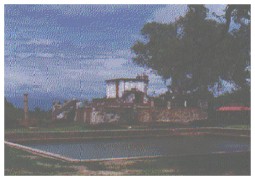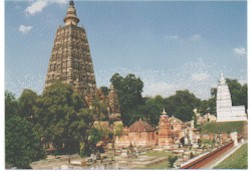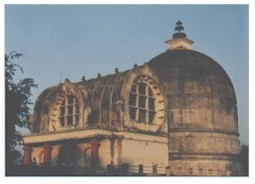| About Us | Site Map | Contact Us |
|
|
| Home | Schools & Teachings | Dharma Centers | Buddha & Bodhisattva Directory | Cosmos |
|
|
Life of the Buddha Gautama
|
The story of the Buddha's personal life, as we will see in the following, is the story of someone who attained full enlightenment through hard work and unwavering dedication. The Buddha was born in the 5th or 6th century B.C. in the Kingdom of Koshala in the Shakhya clan. For twenty years the king Shuddhodana and Queen Maya had no children, then, following Queen's dream of a white elephant that descended from the sky and entered her body, Queen Maya became pregnant.
At the age of 16, Shuddhodana married his cousin, a princess named Yashodhara, and had a son named Rahula ("obstacle") at the age of 29. At the age of 29, Shuddhodana reportedly journeyed outside the palace for the first time, and for the first time saw things that had been previously hidden from him. These things are known now as the Four Omens: (1) an old person [old], (2) a sick person [sickness], (3) a corpse [death], and (4) a holy man (sramana) [ascetic]. The ascetic said to Siddhartha: "I am a bramana, an ascetic, who in fear of birth and death have left home life to gain liberation." These words from the sramana inspired Siddhartha to cut his hair and take up the religious life as a way to solve the problem of old age, sickness, and death. |
|
His initial reaction to these experiences was to adopt the austere lifestyle of an ascetic, engaging in a spiritual path involving great physical penances. During this period, Shuddhodana studied and mastered various religious ideas - Brahmanic, Yogic, and ascetic. Because of his ascetic practices, he is referred as the Shakyamuni, which means the silent one (-muni: denotes one who leads the contemplative life) of the Shakyas. After six years in the forest, he discovered that the true path out of suffering lies in the middle way between the asceticism and self-indulgent luxury. He bathed in the river and accepted a bowl of milk rice from Sujata, a maid who lived in the neighboring village Senanigama. The five disciples who had lived with Shuddhodana for the six years of his ascetic practices were disappointed at his rejection of extreme asceticism and left him in disgust.
After 49 days of meditation, he achieved enlightenment while watching the morning star rise at dawn. He saw into the essential nature of reality and existence. It was December the 8th, when he was thirty-five years of age that Shuddhodana became Buddha. He proceeded to Deer Park in Sarnath, gathered his five disciples around him, and announced to them that he is now a "fully awakened one". The Buddha then delivered to them his first sermon, known as the "the first turning of the wheel of Dharma", the principles of the Four Noble Truths. With this sermon the Buddha begins his 45-year public ministry. The Buddha and his disciples separated to preach the doctrine throughout India. At the age of 80, the Buddha stopped at Vaisali on the way from Rajagriha to Sravasti, he became ill and predicted that after three months he would enter Nirvana. Still he journeyed on until reached Pava where he was made critically ill by food offered by Cunda, a blacksmith.
Seven of the neighboring rulers under the lead of King Ajatasatru demanded that the ashes be divided among them. The King of the Kunsinagara castle at first refused and the dispute even threatened to end in war, but by the advice of a wise man named Dona, the crises passed and the ashes were divided and buried under eight great monuments (Stupas). |
| About Us | Free Books | Site Map | Contact Us | ||
| Copyright © 1999-2020 Manjushri. All Rights Reserved. | ||

 According to their custom the Queen returned to her mother's home for the
birth, and while on the way, in the beautiful spring sunshine, the Prince
was born in a flower garden of Lumbini Park on the eighth day of April.
The Prince was given the name Siddhartha (Pali Siddhatta), which means
"Every wish fulfilled." On the seventh day after his birth, his mother Queen
Maya suddenly passed away. The Prince was brought up by Queen's sister
Mahaprajapati Gautami, Shuddhodana's second consort.
According to their custom the Queen returned to her mother's home for the
birth, and while on the way, in the beautiful spring sunshine, the Prince
was born in a flower garden of Lumbini Park on the eighth day of April.
The Prince was given the name Siddhartha (Pali Siddhatta), which means
"Every wish fulfilled." On the seventh day after his birth, his mother Queen
Maya suddenly passed away. The Prince was brought up by Queen's sister
Mahaprajapati Gautami, Shuddhodana's second consort. Shuddhodana thus remained alone and seated himself under a pipal
(bodhi) tree located in Bodh-Gaya. He then said to himself,
"Blood may become exhausted, flesh may decay, bones may fall apart,
but I will never leave this place until I find the way to enlightenment."
Shuddhodana thus remained alone and seated himself under a pipal
(bodhi) tree located in Bodh-Gaya. He then said to himself,
"Blood may become exhausted, flesh may decay, bones may fall apart,
but I will never leave this place until I find the way to enlightenment." Then by easy stages in spite of great pain and weakness, he reached the
forest on the border of Kuninagara castle. Lying between two large sala
trees, he continued his teachings to his disciples until the last moment.
A week after his last public teaching, the Buddha entered the Great Nirvana,
and his body was cremated by the Mallas in Kusinara.
Then by easy stages in spite of great pain and weakness, he reached the
forest on the border of Kuninagara castle. Lying between two large sala
trees, he continued his teachings to his disciples until the last moment.
A week after his last public teaching, the Buddha entered the Great Nirvana,
and his body was cremated by the Mallas in Kusinara.